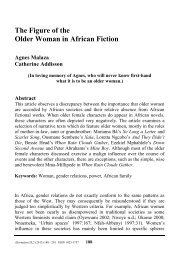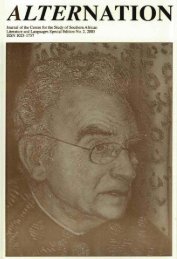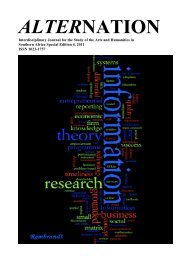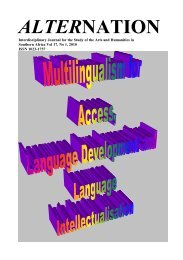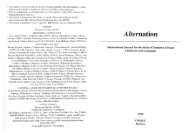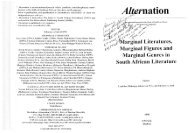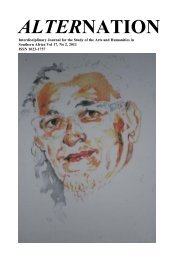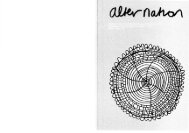Shane Moran - Alternation Journal
Shane Moran - Alternation Journal
Shane Moran - Alternation Journal
You also want an ePaper? Increase the reach of your titles
YUMPU automatically turns print PDFs into web optimized ePapers that Google loves.
osition of dependency and penury.<br />
hen one acqulres power and the economic success that goes w~th tt, one becomes<br />
honoured and often one 1s not shy to perform one's success Thus in a post-colony,<br />
'~nater~al prospellty IS one of the chlef pohttcal vlrtues rather than [the] oblect of<br />
disapproval' (Bayal-t 1993 242) Wh~le wrltlng Devzl Ngugr must have been conscrous<br />
of the fact that boasting about one's wealth m Kenya is past of the soc~al norln As<br />
Angelique FJauge~ud (199.5 I) reinlnds us, 'Exuberant showmansh~p is one endurtng<br />
face ot Kcnyan polit~cal I~fe' Tt is not unusual to come actoss poltt~cians boast~ng about<br />
tlie~~ wealth and wlth great admn-at~on fioin the people Very much In the eally days of<br />
Kenya's ~ndependence, Jomo Kenyatta-the first president of Kenya-ndlculed the<br />
rad~cal natlonaltst opponent, Bildad Kaggla, for Ca~hng to amass wealth fol 111mselF<br />
'Look at Kuiigu Kaiumba', Kenyalta told Kaggta 'He has ~nvested In buses and has<br />
earned money, but what have you done for yourself stnce independence?" About two<br />
decades later, Mr Oloit~pt~p, one of Pres~dent Mol's ministeis, boasted to h ~s pol~t~cal<br />
opponents in pal llament In sent~lnents very si~nllar to Kenyatta's when he declared<br />
I've got money. J don't sell chickens .... I am able to spend 150 million<br />
sliillings from nly own pockct for the marriage of niy son .... 1 Ilave six cat-s,<br />
two big houses, twelve wives and sixty-seven cllildren.<br />
Turning to his opponents, he reminded thein that they 'are not small men, they are men<br />
of big bellies like Oloittptip' (The Weekly Revlew March 30 1984 if). Forty years later<br />
the populist deputy J M Kariuki had absolutely no need to disguise his wealth 111 order<br />
to win credibil~ty wlth the citirens-the 'wananchi' (see Odinga 1992.63). Thus the<br />
'politics of the belly', to use Bayart's phrase, is very much in the iinag~nation of<br />
Kenyans and is notjust a fictive creation ofNgugi.<br />
Ngugi's intervention lies in his insistence that the 'politics ofthe belly' ought to be<br />
the object of ridicule rather than emulation. The belly which the rulers in particular<br />
encode as a sign of success exposes the parasitic nature of the local comprador In a post-<br />
colony. Thus far from confirming their authority, the grotesque image of rulers like<br />
Oloitiptip, should serve to undennine the power of the iulers by turning them into<br />
pitiable objects of ridicule. After all 'the body ~tself is the pr~ncipal locale of the idioms<br />
and fantasies used in depicting power' (~bembe 1992:7).-1f~en~ans ~n thelr igrtorance<br />
have associated 'the big belly' with power, then Ngugi is forcing them to debunk the<br />
myth, and to real~se that the authority ofthe local rulers IS borro\ved<br />
It 13, therefore, to the natute of the locitl comprador bourgeoiste that Ngugt<br />
dtaws our attentlo11 by ustng the grotesque mode in his depiction of them Indeed<br />
grotesque characters, marked as they are by bodily defic~encics or delormation, ~vould<br />
seem to offer Ngrlgl a perfect means of figuring the qual~ties that have tended to<br />
'<br />
Tilt. T~P~~Ps 11 fZp~.il 1900. Nairobi, as quoted in Odinga (1967:3 10). Sce also Ngugi<br />
(1 98 1 a:8L)) and his rcScrencc to Kenyalta's upl.aidingofKaggia.<br />
char-acteTtse either the local comprador or the ruling el~te In the post-colon~al state in<br />
Africa2 The use ofthe grotesque mode draws the readers' attention to the body as a slte<br />
upon wh~ch power is contested If the Kenyan government had ~ntended to subdue<br />
Ngugi's body, he turns the butt on them. 111 Detazned, he talks of his objective:<br />
I would chcat them out of that last laugh by letting my imagination loose<br />
over the kind of society this class, in nakedly treacherous alliance with<br />
imperialist foreigners, were building in Kenya in total cynical disregard of<br />
tlie wishes of over fourteen lnillioli Kenyans (Ngugi 198 1 a: 10).<br />
Yet, the fill significance of the grotesque image in the text only makes sense when<br />
linked to a couple of sub-narratives in Devil.<br />
The first is derived fi-om Wariiiiga's nightmare. In the grotesque image of the<br />
Devil that Wariinga sees, Ngugi seems to suggest a linear and continuing relationship<br />
between the Devil (read colonialism) and the black elite (read colnprador bourgeoisie)<br />
that takes over at independence. Ngugi further suggests that the desire ofthe comprador<br />
class which rescues the devil, thereby introducing a new form of colonialis~n, is to<br />
inherit the Devil's worst qualities. The second consists of three stories that Gatuiria<br />
relates to his fellow passengers on their way to Illnorog in a nznturu. Common to all the<br />
stories are the themes of avarice and conceit. The first story is about the peasant farmer<br />
that was turned into a beast of burden by an ogre (Ngugi 1987:62). The second story is<br />
about the black and beautiful girl who rejected all the men in her country and took to the<br />
first young lnan from a foreign countly. The young foreigner turned out to be a maneating<br />
ogre who tore off her 'limbs one by one and ate them' (Ngugi 1987:62). The third<br />
and last story that Gatuiria relates is about an old man called Nding'uri who had a soul<br />
that was richly endowed. He was well respected, hardworking and displayed neither<br />
desire nor greed for other people's property until, one day, 'a strange pestilence attacked<br />
tlie village' and destroyed all his possessions (Ngugi 1987:63). Nding'uri was forced to<br />
turn to the evil spirits. 'At the entrance to the cave', we read, 'he was ]net by a spirit in<br />
the shape ofan ogre'. We are further told that the ogre<br />
had Lwo mouths. one on his forehead and tlie other at thc back ofllis llcad.<br />
The one at the back oi'his head was covercd by his long hair. and it was only<br />
visible wlie~i thc wind blew the hair aside (Ngugi 1987:61).<br />
The thlust ofthenarrat~ve IS that Ndmg'ur~ surrenders hts soul to the ogle who demands<br />
it 111 exchange for riches Ndmg'urt is tu~ned 'mto an eatel of human tlesh and a dl inker<br />
of human blood' (Ngugi 1987 64) And m a typ~cal Bakht~nlan conceptlor1 of the<br />
glotesque image ot the body-the<br />
t evol t~ng, we read that<br />
body as a site for defecation-both laughable and<br />
This also resonates with Fanon's (1968: 120) characterisatioti of tliis class as decadent and<br />
parasitic, uncreative and 'co~npletely canalized into activilies of tllc intet-medial-y type'.<br />
9



